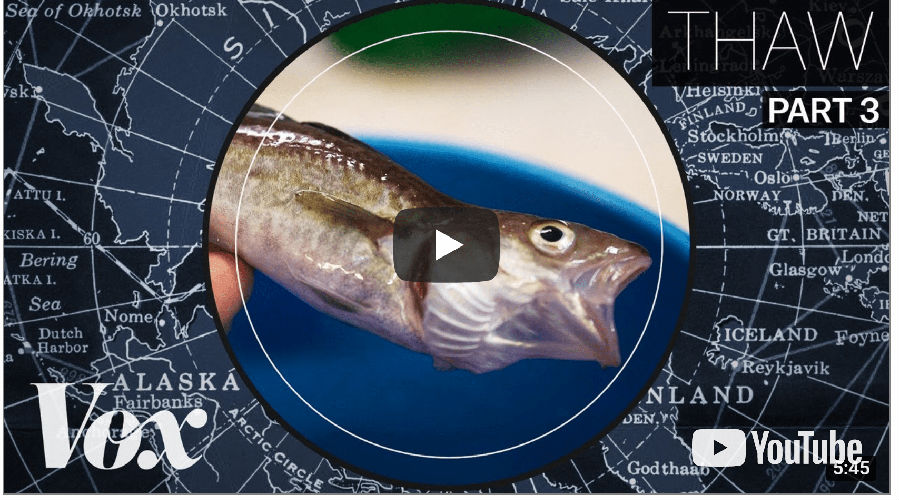As many as half of Earth's species may be already migrating to escape warming temperatures.
为了躲避全球变暖,估计多达一半的地球物种都已经开始迁徙了。
Plants are inching northward and so are many animals.
植物在慢慢向北流动,动物也不例外。
The Arctic ecosystem is particularly vulnerable to invasion.
然而,北极的生态系统特别容易受到入侵的影响。
Scientists aboard this research ship are hunting the most important fish in the Arctic: polar cod.
这艘研究船上的科学家正在捕捞北极最重要的鱼类:极地鳕鱼。
Mixed in with the Arctic fish are invaders including Atlantic cod and capelin.
与北极鳕鱼混在一起的是大西洋鳕鱼和毛鳞鱼等侵略者。
There's more Atlantic than I had expected.
这次捞上来的北极鳕鱼的数量比我想象的要多。
We have polar cod and Atlantic cod in the same net.
一次能够同时捞到北极鳕鱼和大西洋鳕鱼。
The southern species compete for polar cod's food.
来自南方的大西洋鳕鱼在争夺极地鳕鱼的食物。
There's an army from the north and an army from the south, and they...they fight a battle,
南方的鱼群和北方的鱼群在相互……相互竞争,
and at the moment it is the army from the south that is really expanding.
就目前来看,正在壮大的南方的鱼群。
So here is a very typical Arctic food web or food chain.
这里有一个非常典型的北极食物网或食物链。
This food web is changing now.
现在,这个食物网已经在发生变化了。
These fish are among many species migrating into the warming Arctic.
这些鱼不过是迁徙到正在变暖的北极的许多物种中的几种。
Relatively few species have evolved to survive its frigid darkness.
只有相对较少的物种已经进化到能够在寒冷的黑暗中生存的水平。
Polar cod have some of the most impressive adaptations to survive.
极地鳕鱼有着惊人的生存适应能力。
They have this antifreeze proteins. So, compounds that kind of make them be able to live in water that is below zero tempratures.
他们体内含有这种防冻蛋白,就是一种能够让它们在零度以下的水中生存的化合物。
They use a trick that's common among arctic animals, they store lots of fat in their bodies.
他们用一种在北极动物中很常见的技巧,那就是他们会在体内储存大量脂肪。
Polar cod eat tiny copepods, which also store fat to survive the long winter.
极地鳕鱼以小桡足类动物为食,而这种小动物也会存储脂肪来熬过漫长的冬季。
The most important zooplankton species in the Arctic.
桡足动物是北极圈最重要的浮游生物。
They convert the algae diet into lipids, and they store it in their body in the form of lipid sac.
他们能够将摄入的藻类转化成脂类,并以脂质囊的形式储存在体内。
Which makes them a very high energy source as a prey item for higher predators.
对食物链上层的动物来说,它们无异于一种高能食物。
And a high energy meal is crucial for surviving the harsh Arctic.
高能量膳食对于生存在严酷的北极地区至关重要。
One trawl after another reveals southern interlopers.
一次接一次的拖网带来了南部的闯入者。
Out of a thousand fish caught in this trawl, roughly 70% by weight are southern species.
在这个拖网捕获的一千条鱼中,约有70%的鱼都是南方物种。
It's hard for the scientists to pinpoint precisely when we cross the boundary between Atlantic and Arctic waters, but that boundary has been slowly creeping northward.
尽管科学家很难准确地说出我们何时跨越了大西洋和北极海域的边界,但这个边界已经开始向北缓慢推进。
Scientists call this process the 'Atlantification' of the Arctic.
科学家们将这一过程称之为北极的“大西洋化”。
Atlantic waters are saltier and they mostly lack ice.
大西洋水域的水更咸,并且很少有冰。
The biggest difference? Atlantic water is as much as seven degrees warmer.
那两者最大的区别是?大西洋的水温比北极的水温高出七度。
The polar Cod likes the colder water, but it's losing territory.
极地鳕鱼喜欢寒冷的海水,但它正在失去它的领土。
They have a limitation in the north and they have a limitation in the south.
它们的生活范围在南北都有界限。
Polar Cod flourish in the shallow waters of the Barents Sea, but further north it's too deep for them.
极地鳕鱼在巴伦支海浅水区非常活跃,但再往北它们就会觉得水太深了。
Southern border is being pushed further and further north.
南边的界限在逐渐往北移动。
Their habitat is shrinking, getting smaller and smaller.
它们的栖地正在缩减,已经越来越小了。

Meanwhile, the warmer waters bring with them new species that are shaking up the food web.
与此同时,温暖的水域带来的新物种正在瓦解这里的食物网。
Along with new fish, there are Atlantic varieties of copepods.
除了新的鱼类,大西洋桡足类动物也被带到了这里。
They store much less fat than copepods native to the Arctic, making them a less nutritious food source.
它们体内储存的脂肪比北极原生的桡足类要少得多,作为食物来源它们含有的营养显然是不够的。
That means polar cod may have to spend more energy hunting.
这就意味着极地鳕鱼在寻找食物的时候要消耗更多的能量。
For the same amount of animals that are gonna be eaten, you don't transfer the same amount of energy.
同样数量的食物,含有的能量水平却出现了差异。
Capelin, as well as Atlantic Cod, were among the invaders we just caught in the trawl.
毛鳞鱼和大西洋鳕鱼都是我们刚刚在拖网中捕捞到的入侵者。
Capelin will also feed on the same prey as the polar cod, so we start adding competition between these two species.
毛鳞鱼也会和极地鳕鱼争夺食物,所以这两个物种之间又多了竞争的问题。
The Atlantic Cod goes one step further: it eats the polar cod itself.
相比之下,大西洋鳕鱼要更胜一筹:因为它连极地鳕鱼都吃。
Capelin's not as rich as polar cods, so if that goes or diminishes, then these levels will also be impacted.
毛鳞鱼的数量不像极地鳕鱼那么丰富,所以,如果这种情况继续下去,那食物链这一级的动物也会受到影响。
It's easy to vilify the southern species threatening the ecological balance here.
这让人很容易去诋毁威胁了这个地方生态平衡的那些南部物种。
But take the Atlantic cod, in their natural habitat, overfishing and now rising temperatures have decimated its population.
但是,就拿大西洋鳕鱼来说,在他们的自然栖息地,过度捕捞以及不断上升的气温已经使它们的数量变得越来越少了。
So here in the Arctic, Atlantic Cod seems like an invader,
所以,虽然在北极地区,大西洋鳕鱼看似是一个入侵者
but it's also a climate refugee from the south and its main predator is another key species advancing northward.
但它也是南方气候变暖的难民,它的主要捕食者也是另一个向北推进的重要物种。
The most important sourthern invader into the Arctic might be us, humans.
来自南方的侵略者中,最重要的恐怕要数我们人类。
Why did you come to the Arctic?
你为什么来北极?
Fascination. Knowledge, of course. To look for copepods and phytoplankton and see waht they are doing.
对北极的迷恋。当然是求知欲呗。来找桡足类和浮游植物,看看它们的样子。
The crew will likely boil them and serve them for diner tonight.
我们可能会把这些东西煮煮当今天的晚餐。
Pretty tasty.
还挺好吃的。
Historically, most humans who have come to the Arctic have taken a lot more than data and a few samples.
从历史来看,来到北极的大多数人类带走的远远不止是一些数据和标本。
For at least 45,000 years, people have been coming to this paradoxical region.
至少4万5千年来,人们都在不断涌入这个矛盾的地区。
Punishing, desolate but rich with resources.
这个耗费体力的,荒凉,但资源丰富的北极地区。
Humans are the Arctic's ultimate apex predator and yet we're only getting started.
人类是北极的顶级食肉动物,目前的探索还只是个开端。
With countries like Norway extracting fossil fuels offshore, other sectors are also expanding northward.
挪威等国家开采海上矿物燃料,其他行业也在向北扩展。
From tourism, to shipping, to military operations.
从旅游到航运,再到军事行动。
So the stressers in the Arctic are probably going to intensify.
所以北极地区的人员可能会加剧。
As the climate here changes so will the meaning of the word Arctic.
由于这里的气候发生变化,北极这个词的含义也会发生变化。
For the animals who, for now, call it home.
对于那些现在称之为家的动物来说。


